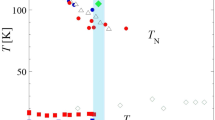Abstract
THE electron spin resonance method is capable of giving fairly detailed information concerning the electron structure of molecules having unpaired electrons. In the past few years D. J. E. Ingram et al. have made detailed investigations of the electron spin resonance absorption of single crystals of hæmoglobin and myoglobin compounds. The most accurate measurements on high-spin ferri-hæmoglobin and ferrimyoglobin compounds have been made at liquid air or liquid hydrogen temperatures and a well-defined variation of g-value from g = 2 to g = 6 was obtained1–4. Very similar g-values were observed in polycrystalline samples of the prosthetic group hæmin at liquid air temperatures1,2,5. No electron spin resonance spectrum was obtained in hæmatin. Measurements in frozen aqueous solutions at 170° K on some hæmoproteins have been reported by A. Ehrenberg6. I have recently summarized much of this work up to the first part of 19637.
This is a preview of subscription content, access via your institution
Access options
Subscribe to this journal
Receive 51 print issues and online access
$199.00 per year
only $3.90 per issue
Buy this article
- Purchase on Springer Link
- Instant access to full article PDF
Prices may be subject to local taxes which are calculated during checkout
Similar content being viewed by others
References
Bennett, J. E., Ingram, D. J. E., George, P., and Griffith, J. S., Nature, 176, 394 (1955).
Ingram, D. J. E., Bennett, J. E., George, P., and Goldstein, J. M., J. Amer. Chem. Soc., 78, 3545 (1956).
Bennett, J. E., Gibson, J. F., and Ingram, D. J. E., Phys. in Med. Biol., 1 (1957).
Gibson, J. F., Ingram, D. J. E., and Schonland, D. S., Disc. Faraday Soc., 26, 72 (1958).
Schoffa, G., Ristau, O., and Jung, F., Naturwiss., 10, 227 (1960).
Ehrenberg, A., Arkiv. Kemi, 19, 119 (1962).
Schoffa, G., Elektronenspinresonanz in der Biologie (G. Braun, Karlsruhe, 1964).
Searl, J. W., Smith, R. C., and Wyard, S. J., Proc. Phys. Soc. (Lond.), 74, 491 (1959).
Ristau, O., and Schoffa, G., Hochfrequenzspektroskcopie, edit. by Lösche, A., and Schütz, W., 152 (Akademie-Verlag, Berlin, 1961).
Ibers, J. A., and Swalen, J. D., Phys. Rev., 127, 1914 (1962).
Sands, R. H., Phys. Rev., 99, 1222 (1955).
Beinert, H. E., and Sands, R. H., Biochem. Biophys. Res. Commun., 3, 41 (1960).
Walsh, W. M., Rupp, L. W., and Wyluda, B. J., Proc. First Intern. Conf. Paramagnetic Resonance, Jerusalem, 1962 (Academic Press).
Griffith, J. S., Biopolymers, Symposia No. 1 (1964), 35 (John Wiley, New York, 1964).
Castner, T., Newell, G. S., Holton, W. C., and Slichter, C. P., J. Chem. Phys., 32, 668 (1960).
Griffith, J. S., Mol. Phys. (in the press).
Author information
Authors and Affiliations
Rights and permissions
About this article
Cite this article
SCHOFFA, G. Electron Spin Resonance in Hæmin, Hæmatin and Hæmoglobin at 4.2° K. Nature 203, 640–641 (1964). https://doi.org/10.1038/203640a0
Issue Date:
DOI: https://doi.org/10.1038/203640a0
Comments
By submitting a comment you agree to abide by our Terms and Community Guidelines. If you find something abusive or that does not comply with our terms or guidelines please flag it as inappropriate.



